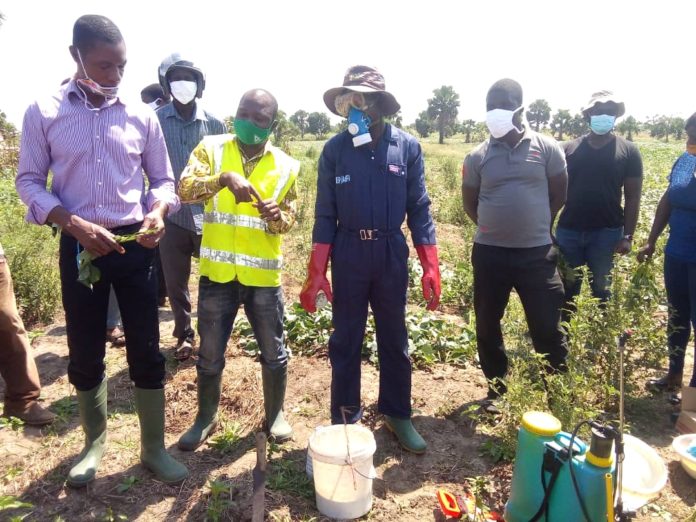INTRODUCTION
“Unlocking the Potential of Rural Youth: Harnessing Agricultural Technology for Sustainable Growth”
Africa’s rural youth communities hold the key to unlocking the continent’s agricultural potential. With over 70% of Africa’s population residing in rural areas, and 60% of the workforce engaged in agriculture, the sector’s growth is crucial for poverty reduction and economic development (AFDB, 2020). However, rural youth face significant challenges, including limited access to education, training, and resources, resulting in a brain drain and urban migration (FAO, 2019).
Yet, a new era of agricultural technology (AgTech) offers unprecedented opportunities for rural youth to drive innovation, entrepreneurship, and sustainable growth. According to a report by the International Fund for Agricultural Development (IFAD), digital agriculture could increase agricultural productivity by up to 70% and reduce poverty by 20-30% (IFAD, 2020).
This article explores the transformative potential of AgTech for rural youth communities, highlighting successful initiatives, entrepreneurial opportunities, and the policy support needed to overcome barriers to adoption.
CHALLENGES FACING RURAL YOUTH COMMUNITIES
Rural youth communities in Africa encounter numerous challenges that hinder their potential and limit their opportunities.
1. Limited Access to Education and Training
- 40% of rural youth lack access to secondary education (UNESCO, 2020)
- Limited vocational training and skills development programs (ILO, 2019)
2. Insufficient Job Opportunities and Career Advancement
- 60% of rural youth are unemployed or underemployed (AFDB, 2020)
- Limited access to markets, finance, and technology (FAO, 2019)
3. Brain Drain and Urban Migration
- 50% of rural youth migrate to urban areas in search of better opportunities (UNDP, 2020)
- Loss of skilled and educated youth, exacerbating rural poverty (IFAD, 2020)
4. Limited Access to Resources and Infrastructure
- 30% of rural communities lack access to electricity (IEA, 2020)
- Inadequate transportation, storage, and irrigation facilities (FAO, 2019)
5. Social and Cultural Barriers
- Limited participation of women and girls in decision-making processes (UN Women, 2020)
- Cultural norms and expectations constraining youth innovation and entrepreneurship (ILO, 2019)
These interconnected challenges perpetuate poverty, inequality, and social exclusion, undermining the potential of rural youth to drive Africa’s agricultural transformation.
THE ROLE OF AGRICULTURAL TECHNOLOGY
Agricultural technology (AgTech) has the potential to revolutionize the agricultural sector in Africa, particularly for rural youth. By leveraging digital solutions, precision agriculture, and innovative business models, AgTech can increase productivity, improve decision-making, and enhance market access.
Digital Agriculture
Digital agriculture, which involves the use of digital technologies such as mobile apps, satellite imaging, and big data analytics, has shown significant promise in improving agricultural productivity. For instance, a study by the International Fund for Agricultural Development (IFAD) found that digital agriculture can increase agricultural productivity by up to 70% and reduce poverty by 20-30% (IFAD, 2020). Similarly, a report by the Food and Agriculture Organization (FAO) highlights the potential of digital agriculture to improve agricultural efficiency, reduce waste, and enhance decision-making (FAO, 2019).
Precision Agriculture
Precision agriculture, which involves the use of advanced technologies such as drones, satellite imaging, and precision irrigation, can significantly improve crop yields and reduce waste. According to a report by the African Agricultural Transformation Initiative, precision agriculture can increase crop yields by up to 20% and reduce water usage by up to 30% (AATI, 2020).
Mobile Applications
Mobile applications have also emerged as a key tool for rural youth to access agricultural information, markets, and financial services. For example, the Ethiopian Agricultural Transformation Agency’s (ATA) mobile app has reached over 1 million farmers, providing them with critical information on weather, soil health, and market prices (ATA, 2020).
E-Extension Services
E-extension services, which involve the use of digital platforms to provide agricultural extension services, have also shown significant promise. A study by the International Centre for Tropical Agriculture (CIAT) found that e-extension services can increase farmers’ knowledge by up to 40% and improve agricultural productivity by up to 25% (CIAT, 2019).
Impact on Rural Youth
The adoption of AgTech has significant implications for rural youth. By providing access to digital platforms, precision agriculture, and mobile applications, AgTech can:
- Improve agricultural productivity and income
- Enhance decision-making and market access
- Increase access to financial services and markets
- Provide opportunities for entrepreneurship and job creation
- Support climate-resilient agriculture
According to a report by the African Development Bank (AFDB), the adoption of AgTech can create up to 1 million jobs for rural youth in Africa by 2025 (AFDB, 2020).
OPPORTUNITIES FOR RURAL YOUTH
The adoption of agricultural technology (AgTech) presents numerous opportunities for rural youth to drive innovation, entrepreneurship, and sustainable growth.
Entrepreneurial Opportunities
Rural youth can leverage AgTech to establish innovative businesses, creating employment opportunities and improving livelihoods. For instance, a study by the International Labour Organization (ILO) found that agricultural entrepreneurship can provide up to 50% higher income for rural youth compared to traditional farming (ILO, 2020). In Africa, agricultural entrepreneurship has created over 1 million jobs for youth, with the potential to create up to 5 million more by 2030 (AFDB, 2020).
Digital Agriculture Services
Rural youth can provide digital agriculture services, such as precision agriculture consulting, drone-based crop monitoring, and mobile-based agricultural advisory services. According to a report by the Food and Agriculture Organization (FAO), digital agriculture services can generate up to $1.5 billion in revenue annually in Africa (FAO, 2020).
E-Commerce and Market Access
AgTech enables rural youth to access global markets through e-commerce platforms, increasing their income and improving livelihoods. For example, the African Agricultural Transformation Initiative (AATI) has established an e-commerce platform connecting rural farmers to global markets, resulting in a 30% increase in income for participating farmers (AATI, 2020).
Agricultural Innovation Hubs
Rural youth can establish agricultural innovation hubs, providing incubation services, training, and mentorship to fellow youth. The Kenya Agricultural and Livestock Research Organization (KALRO) has established innovation hubs, supporting over 500 youth-led agricultural startups and creating up to 2,000 jobs (KALRO, 2020).
Skill Development and Employment
AgTech requires specialized skills, creating opportunities for rural youth to develop expertise in areas such as precision agriculture, data analysis, and digital marketing. According to a report by the International Centre for Tropical Agriculture (CIAT), AgTech can create up to 100,000 skilled jobs for youth in Africa by 2025 (CIAT, 2020).
Policy Support and Investment
To harness these opportunities, policymakers and investors must provide supportive policies, funding, and infrastructure. The African Development Bank (AFDB) has committed $1.5 billion to support AgTech development in Africa, while governments such as Rwanda and Kenya have established AgTech-friendly policies and regulations (AFDB, 2020).
OVERCOMING BARRIERS TO ADOPTION
Overcoming Barriers to Adoption: Enhancing Agricultural Technology Uptake among Rural Youth
Despite the potential of agricultural technology (AgTech) to transform rural youth livelihoods, several barriers hinder its adoption.
Infrastructure Challenges
Limited access to electricity, internet, and mobile networks hampers AgTech adoption. According to the International Energy Agency (IEA), 50% of sub-Saharan Africa’s rural population lacks access to electricity (IEA, 2020). Similarly, the African Development Bank (AFDB) reports that 70% of rural Africa lacks access to internet services (AFDB, 2020).
Digital Literacy and Skills
Rural youth often lack the digital literacy and skills required to effectively utilize AgTech solutions. A study by the Food and Agriculture Organization (FAO) found that 60% of rural youth in Africa have limited digital skills (FAO, 2019).
Cost and Affordability
AgTech solutions can be expensive, making them inaccessible to many rural youth. Research by the International Centre for Tropical Agriculture (CIAT) shows that 50% of rural youth in Africa cannot afford AgTech solutions (CIAT, 2020).
Policy and Regulatory Frameworks
Weak policy and regulatory frameworks hinder AgTech development and adoption. The African Agricultural Transformation Initiative (AATI) reports that 40% of African countries lack clear policies supporting AgTech (AATI, 2020).
Social and Cultural Barriers
Social and cultural norms can limit rural youth participation in AgTech. A study by the International Fund for Agricultural Development (IFAD) found that 30% of rural youth in Africa face social and cultural barriers to AgTech adoption (IFAD, 2020).
Strategies to Overcome Barriers
To address these challenges:
Governments and industry players need to Invest in rural infrastructure development, including electricity, internet, and mobile networks. Implement digital literacy and skills training programs for rural youth. Develop affordable and context-specific AgTech solutions. Strengthen policy and regulatory frameworks supporting AgTech and promote social and cultural inclusivity in AgTech adoption.
Initiatives and Success Stories
Several initiatives have successfully addressed these barriers:
- The African Development Bank’s (AFDB) $1.5 billion investment in rural infrastructure development.
- The Food and Agriculture Organization’s (FAO) digital literacy program, reaching 100,000 rural youth.
- The International Centre for Tropical Agriculture’s (CIAT) affordable AgTech solutions, benefiting 50,000 rural youth.
- The African Agricultural Transformation Initiative’s (AATI) policy support, resulting in 20% increase in AgTech adoption.
CONCLUSION
The potential of agricultural technology (AgTech) to transform rural youth livelihoods in Africa is vast. By leveraging digital solutions, precision agriculture, and innovative business models, AgTech can increase productivity, improve decision-making, and enhance market access.
However, overcoming infrastructure, digital literacy, cost, policy, and social barriers is crucial for widespread adoption. Strategic investments in rural infrastructure, digital skills training, affordable AgTech solutions, policy support, and social inclusivity can address these challenges.
The success stories and initiatives highlighted in this article demonstrate that AgTech can:
- Create employment opportunities and entrepreneurial ventures
- Improve agricultural productivity and income
- Enhance decision-making and market access
- Support climate-resilient agriculture
To realize the full potential of AgTech, stakeholders must:
1. Prioritize rural youth in AgTech development and implementation.
2. Foster public-private partnerships for infrastructure development and funding.
3. Develop context-specific AgTech solutions.
4. Strengthen policy and regulatory frameworks.
5. Promote digital literacy and skills training.
Together, we can unlock the potential of rural youth and AgTech, driving sustainable growth, poverty reduction, and food security in Africa.
Call to Action:
Let us join forces to:
- Support AgTech initiatives and innovations
- Advocate for policy and regulatory reforms
- Invest in rural infrastructure and digital skills training
- Empower rural youth to drive agricultural transformation
RECOMMENDATIONS
Policy Recommendations:
1. Governments should prioritize rural infrastructure development, including electricity, internet, and mobile networks.
2. Establish clear policies and regulatory frameworks supporting AgTech development and adoption.
3. Implement tax incentives and subsidies for AgTech startups and entrepreneurs.
4. Develop programs for digital literacy and skills training for rural youth.
Private Sector Recommendations:
1. Invest in AgTech research and development, focusing on context-specific solutions.
2. Collaborate with governments and organizations to develop affordable AgTech products.
3. Establish mentorship programs and incubation hubs for rural youth entrepreneurs.
4. Develop public-private partnerships for rural infrastructure development.
Civil Society Recommendations:
1. Advocate for policy reforms supporting AgTech adoption.
2. Provide training and capacity-building programs for rural youth.
3. Establish networks and platforms for knowledge sharing and collaboration.
4. Support AgTech entrepreneurship and innovation.
Development Partners Recommendations:
1. Provide funding and technical assistance for AgTech initiatives.
2. Support policy reforms and regulatory frameworks.
3. Collaborate with governments and private sector to develop sustainable AgTech solutions.
4. Monitor and evaluate AgTech impact on rural youth livelihoods.
Research and Development Recommendations:
1. Conduct studies on AgTech adoption and impact on rural youth.
2. Develop context-specific AgTech solutions.
3. Investigate emerging technologies (e.g., AI, blockchain) for AgTech applications.
4. Establish research partnerships between academia, industry, and governments.
Youth Empowerment Recommendations:
1. Develop youth-led AgTech initiatives and organizations.
2. Provide training and mentorship programs for rural youth entrepreneurs.
3. Establish networks and platforms for youth knowledge sharing and collaboration.
4. Support youth participation in AgTech policy development.
GHANA IN PERSPECTIVE
Ghana has made significant progress in agriculture, but challenges persist:
- 25% of Ghana’s population lives below the poverty line (GSS, 2020)
- 50% of youth are unemployed or underemployed (MoYC, 2020)
- Agriculture contributes 20% to Ghana’s GDP, but productivity remains low (MoFA, 2020)
Ghana’s Agricultural Technology (AgTech) Landscape:
- Growing interest in digital agriculture and precision farming
- Government initiatives: Planting for Food and Jobs, Agricultural Development Bank
- Private sector involvement: Agri-tech companies, farmer-based organizations
RECOMMENDATIONS FOR GHANA:
Policy Recommendations:
1. Ministry of Food and Agriculture (MoFA) should develop a comprehensive AgTech policy.
2. Establish a national digital agriculture platform for data sharing and collaboration.
3. Provide tax incentives for AgTech startups and entrepreneurs.
Private Sector Recommendations:
1. Collaborate with MoFA to develop context-specific AgTech solutions.
2. Establish incubation hubs for AgTech entrepreneurs.
3. Develop affordable AgTech products for smallholder farmers.
Civil Society Recommendations:
1. Advocate for AgTech policy reforms.
2. Provide training and capacity-building programs for rural youth.
3. Establish networks for knowledge sharing and collaboration.
Development Partners Recommendations:
1. Support AgTech initiatives and research.
2. Collaborate with government and private sector.
3. Provide funding and technical assistance.
Research and Development Recommendations:
1. Conduct studies on AgTech adoption and impact.
2. Develop context-specific AgTech solutions.
3. Investigate emerging technologies.
Youth Empowerment Recommendations:
1. Develop youth-led AgTech initiatives.
2. Provide training and mentorship programs.
3. Establish networks for youth knowledge sharing.








